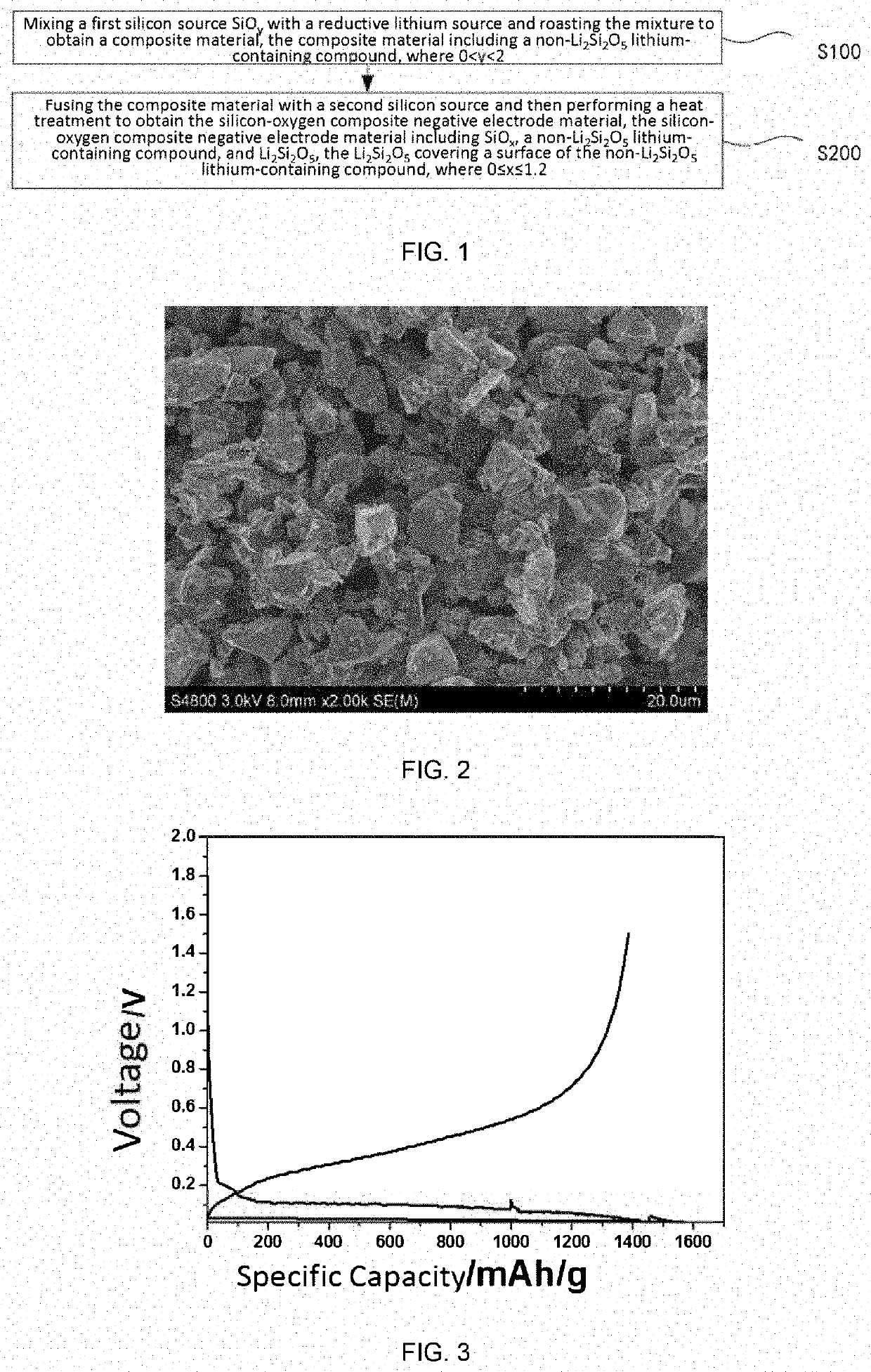Silicon-oxygen composite negative electrode material and method for preparation thereof and lithium-ion battery
a negative electrode material and composite negative electrode technology, applied in the field of negative electrode materials, can solve the problems of affecting the cycling performance, the popularization and use restriction of lithium-ion batteries, and the inability to meet the future demand for high energy density lithium-ion batteries, so as to improve the processing stability of pre-lithiated materials, improve the effect of battery performance and easy soluble in water
- Summary
- Abstract
- Description
- Claims
- Application Information
AI Technical Summary
Benefits of technology
Problems solved by technology
Method used
Image
Examples
example 1
[0144]In this example, a silicon-oxygen composite negative electrode material was prepared according to the following method.
[0145](1) 1 kg of Si powder and 2 kg of SiO2 powder were taken and put into a VC mixer and mixed for 30 min to obtain a mixture of SiO2 and Si. The mixture was put into a vacuum furnace, and heated to 1300° C. under a negative pressure condition with a vacuum degree of 5 Pa and maintained at the temperature for 18 h, so that SiO vapor was generated in the furnace and rapidly condensed (at a condensation temperature of 950° C.) to form a SiO block. The SiO block was processed by crushing, ball milling, and classification processes to obtain a SiO powder material, with a median particle size controlled around 6 μm.
[0146](2) 1 kg of the SiO powder material was taken and placed into a ball milling tank, to which 100 g of lithium hydride was added to perform ball-milling for 20 minutes. The resultant was taken out and placed in an atmosphere protection furnace, roa...
example 2
[0151]In this example, a silicon-oxygen composite negative electrode material was prepared according to the following method.
[0152](1) 1 kg of Si powder and 0.6 kg of SiO2 powder were taken and put into a VC mixer and mixed for 30 min to obtain a mixture of SiO2 and Si. The mixture was put into a vacuum furnace, and heated to 1300° C. under a negative pressure condition with a vacuum degree of 5 Pa and maintained at the temperature for 18 h, so that SiO vapor was generated in the furnace and rapidly condensed (at a condensation temperature of 950° C.) to form a SiO0.5 block. The SiO0.5 block was processed by crushing, ball milling, and classification processes to obtain a SiO0.5 powder material, with a median particle size controlled around 6 μm.
[0153](2) 1.5 kg of the SiO0.5 powder material was taken and placed in a CVD rotary furnace, into which acetylene was introduced as a carbon source and nitrogen was introduced as a protective gas for deposition at 800° C. for 70 min, and the...
example 3
[0160]In this example, a silicon-oxygen composite negative electrode material was prepared according to the following method.
[0161](1) 1 kg of Si powder and 2.0 kg of SiO2 powder were taken and put into a VC mixer and mixed for 30 min to obtain a mixture of SiO2 and Si. The mixture was put into a vacuum furnace, and heated to 1100° C. under a negative pressure condition with a vacuum degree of 5 Pa and maintained at the temperature for 20 h, so that SiOy vapor was generated in the furnace and rapidly condensed (at a condensation temperature of 950° C.) to form a SiO block. The SiO block was processed by crushing, ball milling, and classification processes to obtain a SiO powder material, with a median particle size controlled around 6 μm.
[0162](2) 1.5 kg of the SiO powder material was taken and placed in a CVD rotary furnace, into which methane was introduced as a carbon source and nitrogen was introduced as a protective gas for deposition at 600° C. for 10 h, and the resultant was ...
PUM
| Property | Measurement | Unit |
|---|---|---|
| thickness | aaaaa | aaaaa |
| particle size | aaaaa | aaaaa |
| thickness | aaaaa | aaaaa |
Abstract
Description
Claims
Application Information
 Login to View More
Login to View More - R&D
- Intellectual Property
- Life Sciences
- Materials
- Tech Scout
- Unparalleled Data Quality
- Higher Quality Content
- 60% Fewer Hallucinations
Browse by: Latest US Patents, China's latest patents, Technical Efficacy Thesaurus, Application Domain, Technology Topic, Popular Technical Reports.
© 2025 PatSnap. All rights reserved.Legal|Privacy policy|Modern Slavery Act Transparency Statement|Sitemap|About US| Contact US: help@patsnap.com

